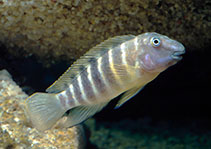|
Eretmodus marksmithi Burgess, 2012 |

|
|
photo by
Muséum-Aquarium de Nancy/D. Terver |
| Family: | Cichlidae (Cichlids), subfamily: Pseudocrenilabrinae | |||
| Max. size: | 4.73 cm SL (male/unsexed) | |||
| Environment: | pelagic; freshwater; depth range 0 - 5 m, | |||
| Distribution: | Africa: endemic to Lake Tanganyika, occurs in the northern two thirds to three-fourths of the lake (Ref. 92306). | |||
| Diagnosis: | Dorsal spines (total): 23-25; Dorsal soft rays (total): 3-5; Anal spines: 3-3; Anal soft rays: 7-8. Diagnosis: Eretmodus marksmithi is characterized by a subterminal mouth and 7-8 light bars extending the full depth of the body from dorsal fin base to ventral side, the last crossing the caudal peduncle (Ref. 92306). A few light blue dots may be present, mainly on the head (Ref. 92306). Description: Body elongate, moderately compressed (Ref. 92306). Depth 3.0-3.2 times in standard length, dorsal profile of head slightly convex from origin of dorsal fin to above eye, then descending steeply to a slightly protruding snout; mouth subterminal, lips thick; eyes set high in head, about level with origin of lateral line (Ref. 92306). Teeth spatulate, some with rounded corners, base narrower, tips brownish shading to almost golden toward base, arranged in 4 separated groups of 3 teeth each on either side of upper jaw, 3 groups of two per group in lower jaw, each group located behind and shifted slightly outside previous row (Ref. 92306). Body scales moderate, 28-30 in lateral series, much smaller on chest; lateral line evident as pale line rising slightly from upper corner of gill cover and paralleling contour of back below dorsal fin base until the 7th light bar, separated from dorsal fin base by two rows of scales anteriorly and one row posteriorly; the posterior portion of the lateral line starts below the beginning of the soft dorsal and runs horizontally to the caudal fin base (Ref. 92306). Colour: Body slate gray, slightly tannish anteriorly, darker dorsally and posteriorly and lighter ventrally; chest and abdomen whitish (Ref. 92306). Eight light vertical bars cross body and caudal peduncle; the first extends from the nape to the upper base of the pectoral fin, this bar fades ventrally and gaps may appear; the following bars are approximately equally spaced along the body, the last crossing the caudal peduncle, and extend from the dorsal fin base to the lower body (Ref. 92306). Scattered pale blue 'spots' present on first bars and scattered yellow spots present posteriorly and on lowerhalf of bars except on the caudal peduncle where they extend from top to bottom (Ref. 92306). Head sooty gray with small light areas on nape and interorbital space and above the eye; blue spots present on opercle; blue spots below eye uniting to become solid blue area covering lower portion of preopercle and ventrally to branchiostegals; lower lip bright blue, upper lip gray with a hint of blue; eye dark grayish with splashes of blue and some yellow-orange on the posterior edge (Ref. 92306). Pectoral fins whitish, pale yellow basally; pelvic fins with spine whitish, rayed portion yellow; caudal fin yellow, lowermost few rays whitish, edge of upper lobe orangish with submarginal blue streak; dorsal fin yellowish with orange-yellow border and submarginal blue stripe, the blue stripe is absent from the first few spine tips; anal fin whitish basally, gradually becoming light yellow distally (Ref. 92306). | |||
| Biology: | Found in shallow (1-2 m deep), well-oxygenated, clear water of the surge zone; bottom composed of small stones varying from 10-40 cm in diameter; feeds on biocover which is scraped from rocks; small invertebrates (crustaceans, mites, insects, insect larvae) are eaten as well; biparental mouthbrooder (Ref. 92306). | |||
| IUCN Red List Status: | Not Evaluated (N.E.) Ref. (130435) | |||
| Threat to humans: | harmless | |||